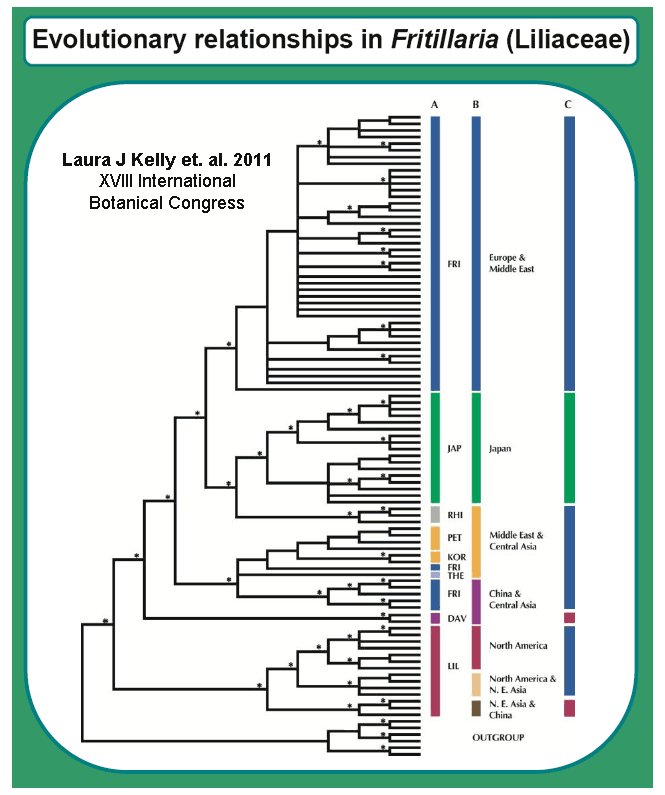NEWS 2011
Evolutionary relationships in Fritillaria (Liliaceae)
Kelly, LJ¹, ², Berger, MR³ Day, PD¹, Leitch, AR², Fay, MF¹, Hill, L⁴, Leitch, IJ¹
XVIII International Botanical Congress 2011 - Melbourne, Australia
ePoster – P0845
¹Royal Botanic Gardens Kew, UK; ²Queen Mary University of London, UK; ³Durham University, Durham, UK; ⁴Petersham Lodge, Richmond, UK
Abstract
Fritillaria (Liliaceae) contains circa 140 species of bulbous perennials, which occur in temperate regions of the Northern Hemisphere. The genus includes taxa of horticultural importance, e.g. F. imperialis and F. persica, as well as those used in traditional medicine, e.g. F. cirrhosa. Eight subgenera were recognised in the most recent classification of Fritillaria, with some of these further subdivided into sections and series. This classification was broadly supported by the results of a previous phylogenetic study based on DNA sequence data from two plastid regions and the nuclear ribosomal ITS region, with species from three of the subgenera that were represented by multiple species forming monophyletic groups. Nevertheless, the largest subgenus, Fritillaria, appeared polyphyletic as the result of a single species (F. pallidiflora) falling as sister to subgenera Korolkowia, Petillium and Theresia in a clade separate to that of the other members of subgenus Fritillaria. Only 37 of the circa 140 species were available for inclusion in the previous work and, as well as contributing to current understanding of species evolution within the genus, the availability of a robust phylogenetic hypothesis for Fritillaria is essential to provide an evolutionary framework for wider studies of the genus, such as research currently being conducted on genome size evolution. We present the latest results from an ongoing molecular phylogenetic study aimed at elucidating relationships between all species of Fritillaria. To date, sequence data have been obtained from >120 individuals, representing >85 species. Our results confirm the polyphyletic nature of subgenus Fritillaria, with species from this group falling within two distinct clades; a main subgenus Fritillaria clade is recovered (comprising around 45 of the species sampled so far), whilst samples from Central Asia and China (eight of the species sampled so far) are placed within a distinct part of the tree. Moreover, all members of the endemic Japanese subgenus Japonica, represented in previous phylogenetic work by a single individual, have now been sequenced, allowing insights into the evolution of these species.

